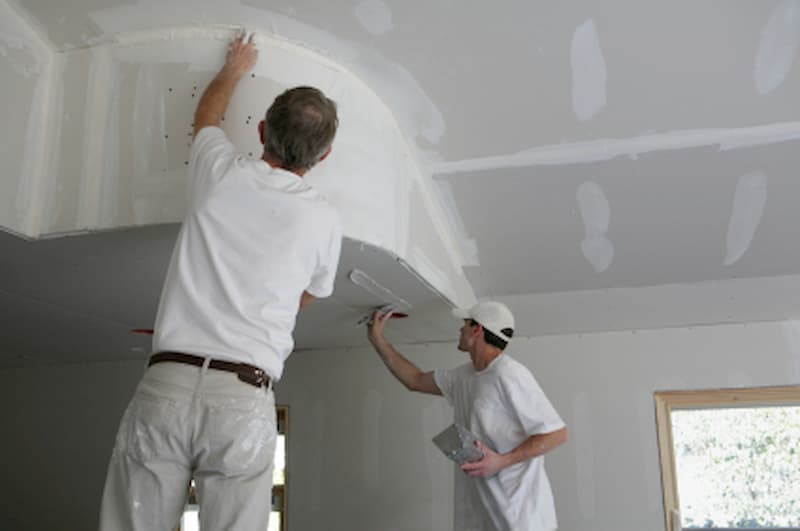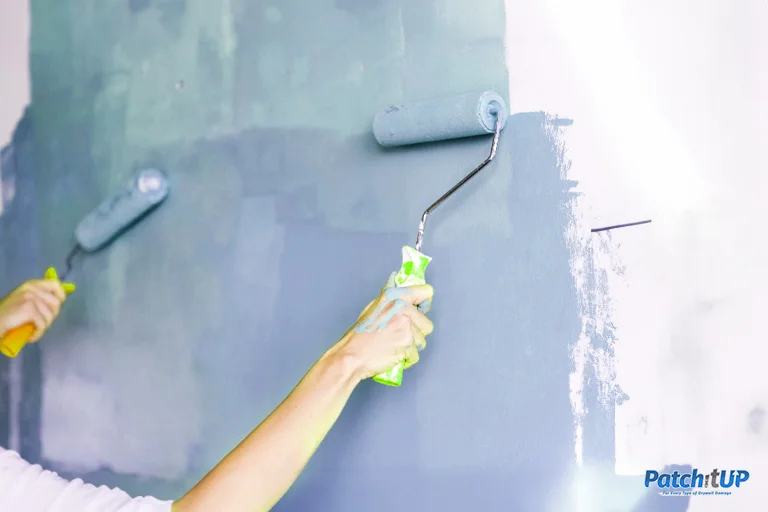Necessary Tips for Effective Drywall Fixing and Installation Methods
Reliable drywall repair service and setup needs a careful method. Comprehending the sorts of drywall and having the right tools is essential. Accurate dimensions and correct techniques can greatly impact the end result. Many neglect vital actions like taping and fining sand, which can make or break the final look. As jobs advance, common challenges might arise that need interest. Discovering these pointers can bring about an extra sleek and successful coating.
Recognizing Various Kinds of Drywall
Comprehending the various kinds of drywall is essential for any successful fixing or installation job. Drywall, commonly understood as gypsum board, comes in a number of varieties customized for particular applications. Criterion drywall is one of the most commonly used type, ideal for basic indoor walls and ceilings. Moisture-resistant drywall, frequently green in color, is created for locations prone to moisture, such as kitchen areas and washrooms. Fire-resistant drywall, typically tinted pink or purple, is crafted to withstand greater temperature levels and is typically utilized in garages or near heaters. In addition, soundproof drywall assists decrease sound transmission, making it appropriate for multi-family homes or tape-recording studios. Specialized drywall, like concrete board, is used in wet areas like showers or bathtub borders. Comprehending these kinds helps in selecting the right product for every task, making sure toughness and performance in repair work or brand-new installments.
Important Devices for Drywall Repair Service and Installment
Having the right tools is essential for effective drywall repair service and setup. A high quality utility blade is vital for cutting drywall sheets precisely. A drywall T-square assists assure straight edges, while a taping knife is necessary for applying joint compound smoothly over seams. Additionally, a drywall saw permits eliminating damaged sections or suitable drywall around fixtures.
For hanging drywall, a power drill with drywall screws is vital, as it enables quick and protected setup. A level is also important to confirm that the drywall is straight and appropriately aligned. A sanding block or pole sander is necessary for smoothing out joint substance once it has actually dried. Finally, a measuring tape is critical for exact measurements, stopping waste and ensuring a correct fit. Geared up with these tools, people can tackle drywall tasks efficiently, causing professional-looking results.
Step-by-Step Overview to Repairing Holes and Cracks
When addressing openings and fractures in drywall, having the right tools and materials is essential for a successful repair work. This overview details the necessary products and offers a clear, step-by-step process to effectively bring back the surface. Understanding these aspects will help assure a seamless surface and lasting outcomes.
Tools and Materials Needed
A well-appointed toolkit is essential for reliable drywall fixing and installation. Secret devices include an energy knife for reducing drywall, a tape step to ensure exact sizing, and a drywall saw for larger holes. A putty knife is essential for using joint substance smoothly, while a sanding block or pole sander aids accomplish a seamless coating. For patching, a roll of fiberglass mesh tape or paper tape is essential to strengthen joints. Furthermore, a drill and screws are needed for protecting brand-new drywall pieces. Essential products consist of joint substance, primer, and paint to finish the repair work. Having these tools and products available ensures a smoother, a lot more effective repair work procedure, yielding professional-looking results.
Repair Work Refine Steps
Fixing openings and splits in drywall calls for a methodical method to guarantee a seamless surface. Initially, the location bordering the damage should be cleansed completely to eliminate dirt and particles. Next off, for tiny fractures, a putty knife is utilized to apply a joint substance uniformly over the area. For bigger holes, a patch is needed; the harmed area is removed, and a brand-new piece of drywall is fitted in place, secured with screws. As soon as the patch remains in position, joint substance is applied to blend the edges. After drying out, sanding the area smooth is essential. The fixed surface ought to be primed and painted to match the surrounding wall, making sure an inconspicuous repair service.
Strategies for Setting Up Drywall Panels
Setting up drywall panels needs mindful preparation and specific implementation to guarantee a expert and smooth surface. Initially, it is important to measure the wall surface space precisely and cut the panels to fit, guaranteeing that they line up with the studs. Placing the panels horizontally is normally recommended, as this can enhance the structural integrity and reduce the variety of seams.
Making use of drywall screws, installers must secure the panels every 16 inches along the studs, guaranteeing a firm hold. It is crucial to avoid overdriving the screws, which can harm the paper surface area. For edges and edges, using an energy knife enables clean cuts and a snug fit.

Completing Touches: Insulation, Mudding, and Sanding
As soon as the drywall panels are firmly in location, the next important step involves the finishing touches of taping, mudding, and sanding. Taping is essential for developing a smooth change in between panels and concealing joints. A high quality drywall tape, either paper or fiberglass fit together, need to be applied over the joints, guaranteeing it adheres appropriately to the mud that will be used following.
Mudding, or using joint substance, follows the taping procedure. This substance fills up gaps check here and smooths out the surface. A first layer ought to be used generously, feathering the sides to blend with the drywall. After the preliminary layer dries out, succeeding layers may be required for a remarkable surface.
Fining sand is required to achieve a smooth surface. A fine-grit sandpaper ought to be made use of to carefully smooth out any imperfections. Treatment should be taken to avoid over-sanding, which can damage the drywall - Drywall Installation Ogden Utah. Correctly implemented, these ending up touches produce an expert appearance ready for painting
Tips for Preserving Your Drywall After Installment
Keeping drywall after setup is crucial to preserving its look and structural integrity. Normal cleaning is required; dirt and dust can gather, so mild cleaning with a damp fabric is recommended. Homeowners need to also evaluate for any signs of wetness or mold and mildew, particularly in high-humidity areas like kitchens and washrooms. If any damage happens, it is very important to address it promptly to avoid further concerns.
Using furniture pads can assist stop scrapes or dents from hefty things. Furthermore, painting the drywall with a high-grade, cleanable paint supplies an additional layer of defense and makes future cleaning simpler. Stay clear of utilizing abrasive cleansers or devices, as these can harm the surface. Keeping a steady indoor environment with proper moisture levels will certainly help avoid splitting or warping over time. By adhering to these suggestions, one can ensure that drywall remains in superb condition for several years ahead.
Frequently Asked Concerns
The Length Of Time Does Drywall Take to Fully Dry After Installment?

Can I Mount Drywall Over Existing Drywall?
Yes, drywall can be mounted over existing drywall, but it is important to assure the underlying surface is secure and sufficiently prepared. This technique can enhance insulation and decrease installment time, though it may include weight.
What Is the most effective Means to Soundproof Drywall?
The finest way to soundproof drywall entails using specialized soundproofing products, such as durable channels, acoustic caulk, and sound-dampening drywall. These methods efficiently minimize sound transmission in between rooms, enhancing general acoustic efficiency in living spaces.
Exactly how Do I Select the Right Drywall Density?
To choose the best drywall density, take into consideration the application and area. Requirement property walls usually make use of 1/2 inch, while ceilings or specialized areas might need 5/8 inch for added stamina and soundproofing capacities.
Are There Eco-Friendly Drywall Options Available?
Yes, eco-friendly drywall choices are available. These include products made from recycled materials, gypsum boards with low unstable natural compounds (VOCs), and those using lasting production processes, offering environmentally-conscious options for construction and restoration projects.
Having the right tools is crucial for effective drywall repair work and installment. For hanging drywall, a power drill with drywall screws is essential, as it makes it possible for secure and fast installment. Key devices include an energy knife for reducing drywall, a tape step to ensure precise sizing, and a drywall saw for larger openings. Yes, drywall can be installed over existing drywall, yet it is essential to guarantee the underlying surface area is secure and properly prepared. The best way to soundproof drywall entails making use of specialized soundproofing materials, such as resilient networks, acoustic caulk, and sound-dampening drywall.